Identification of the nature and mechanism of the zinc doping effect on the normal-state properties of the YBa2Cu3Oy system by a quantitative analysis of the thermopower and Nernst coefficient
IF 1
3区 物理与天体物理
Q4 PHYSICS, APPLIED
Physica C-superconductivity and Its Applications
Pub Date : 2025-08-24
DOI:10.1016/j.physc.2025.1354789
引用次数: 0
Abstract
In this paper, we present the results of an experimental study of the temperature dependences of the thermopower, S, and the Nernst coefficient, Q, in samples of the YBa2Cu3-xZnxOy system with zinc content varying over a wide range. It is shown that, despite the fact that zinc doping has a very slight effect on the absolute values of the transport coefficients at T = 300 K, an increase in its content throughout the entire doping range studied leads to a consistent modification of the S(T) dependences, the nature of which is atypical for the cases of other cation substitutions in the YBa2Cu3Oy system. By analyzing the experimental results within the framework of the narrow-band model, we determined the values of the parameters characterizing the energy spectrum structure and charge carrier system properties in samples of different compositions, and then discussed their variations with increasing zinc content. The obtained calculation results clearly show that zinc substituting for the plane copper directly affects the normal-state energy spectrum of the YBa2Cu3Oy system, and also make it possible to explain all the observed specific features of the behavior of the transport coefficients in the studied system.
通过对YBa2Cu3Oy体系的热功率和能系数的定量分析,确定了锌掺杂对YBa2Cu3Oy体系正常态性能影响的性质和机理
在本文中,我们提出了一项实验研究的结果,该实验研究了锌含量在很大范围内变化的YBa2Cu3-xZnxOy体系样品的热功率S和能系数Q对温度的依赖性。结果表明,尽管锌掺杂对T = 300 K时输运系数绝对值的影响很小,但在整个掺杂范围内锌含量的增加导致S(T)依赖性的一致改变,其性质与YBa2Cu3Oy体系中其他阳离子取代的情况不同。通过在窄带模型框架内对实验结果的分析,确定了表征不同成分样品能谱结构和载流子系统性质的参数值,并讨论了它们随锌含量增加的变化规律。计算结果清楚地表明,锌取代平面铜直接影响了YBa2Cu3Oy体系的正态能谱,也可以解释所观察到的体系输运系数行为的所有具体特征。
本文章由计算机程序翻译,如有差异,请以英文原文为准。
求助全文
约1分钟内获得全文
求助全文
来源期刊
CiteScore
2.70
自引率
11.80%
发文量
102
审稿时长
66 days
期刊介绍:
Physica C (Superconductivity and its Applications) publishes peer-reviewed papers on novel developments in the field of superconductivity. Topics include discovery of new superconducting materials and elucidation of their mechanisms, physics of vortex matter, enhancement of critical properties of superconductors, identification of novel properties and processing methods that improve their performance and promote new routes to applications of superconductivity.
The main goal of the journal is to publish:
1. Papers that substantially increase the understanding of the fundamental aspects and mechanisms of superconductivity and vortex matter through theoretical and experimental methods.
2. Papers that report on novel physical properties and processing of materials that substantially enhance their critical performance.
3. Papers that promote new or improved routes to applications of superconductivity and/or superconducting materials, and proof-of-concept novel proto-type superconducting devices.
The editors of the journal will select papers that are well written and based on thorough research that provide truly novel insights.

 求助内容:
求助内容: 应助结果提醒方式:
应助结果提醒方式:


